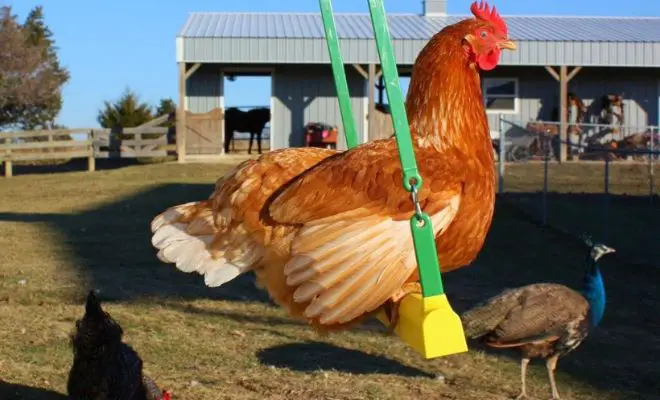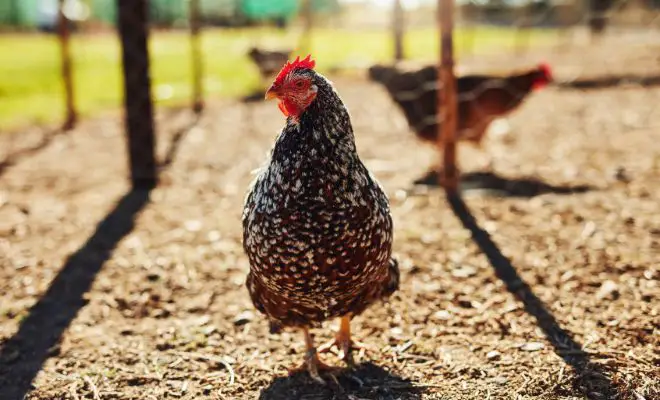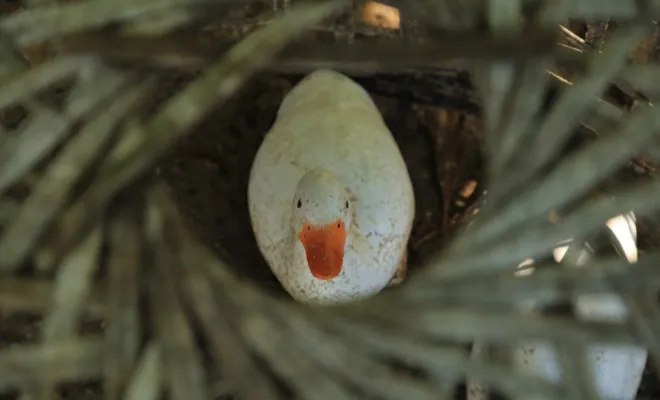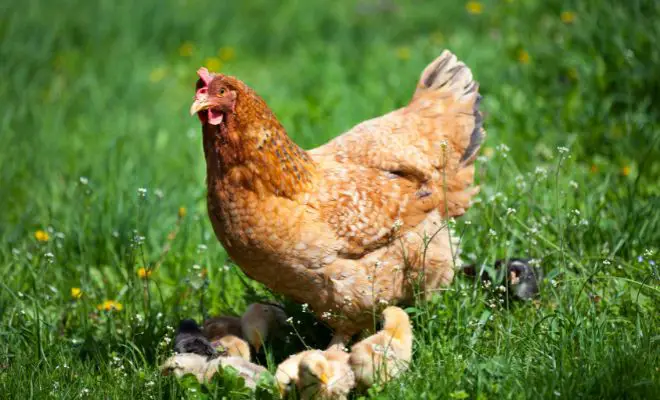9 Best Chicken Run Roof Ideas for All Climates!

Keeping your chickens safe is important, and choosing the right roof for their run is a big part. The best roof should protect them from bad weather, let in fresh air, and keep out from any harm.
But what are the best chicken run roof ideas? First, think about where you live and the weather. If it’s super hot, rainy, or snowy, you’ll need a roof that can handle it all and keep your chickens nice and dry. You can opt for the gabled roof, hip roof, lean-to roof, tin roof, flat roof, combination roof, and more.
In this guide, we’ll check out different roofs you can use to make your chicken run awesome. So, let’s see what’s ideal for your poultry!
Table of Contents
Do You Really Need A Run Roof for Chickens?
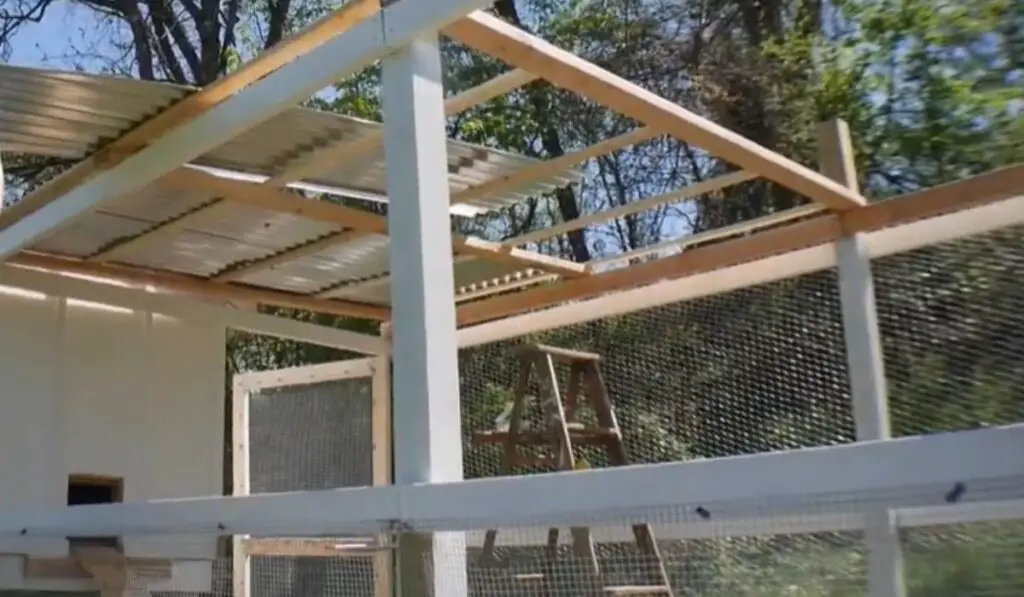
Yes, providing a roof for your chicken run is essential.
While a fully enclosed roof offers the most protection, there are situations where adjustments can be made. Here’s why a covered run is important.
Here’s why having a roof on your chicken run is super important:
- Protection from the Weather: Rain, snow, and too much sun can hurt chickens. A roof keeps them dry when it rains, cool when it’s hot, and warm when it’s cold.
- Stopping Predators: Some animals want to eat chickens, but a roof makes it harder for them to get in. It’s like a big shield that keeps most of them away.
- Stopping Chicken Escapes: Chickens can jump and fly, especially if they get scared. A roof stops them from flying away and getting hurt.
What Are the Roofing Material Options for Chicken? 7 Ideas!
Picking a roof for your chicken run is like picking a hat! Here are the roofing materials you can focus on –
1. Corrugated Metal
Corrugated metal is durable, weather-resistant, and provides excellent protection against rain and snow. It’s also relatively easy to install.
Note: Ensure proper insulation to prevent extreme temperature fluctuations inside the coop.
2. Polycarbonate Panels
Polycarbonate panels are lightweight, and transparent, and allow natural light to filter through. They’re ideal for creating a bright and airy chicken run.
Note: Use UV-resistant panels to prevent yellowing over time.
3. Asphalt Shingles
Asphalt shingles are cost-effective and widely available. They come in various colors and styles, allowing you to match your coop’s aesthetics.
Note: Ensure proper ventilation to prevent moisture buildup under the shingles.
4. Wooden Shingles
Wooden shingles add rustic charm to your chicken run. They’re eco-friendly and blend seamlessly with natural surroundings.
Note: Regularly inspect and replace damaged shingles to maintain their integrity.
5. Thatched Roof
Thatched roofs evoke a tropical vibe and provide excellent insulation. They’re made from dried grass or reeds.
Note: Thatched roofs require occasional maintenance and replacement.
6. Recycled Materials
Recycled materials like Marine-Grade Plywood are sturdy and weather-resistant. So, you can go for such an eco-friendly choice.
Also, the upcycling of old materials adds character and reduces waste.
Note: Both of the options are safe and secure for the chicken coop. Opt for any and keep the coop safe from outside hazards!
7. Shade Cloth
Shade cloth provides partial coverage. It allows sunlight while protecting against excessive heat.
Note: Use shade cloth in hot climates or as a temporary solution.
What Type of Roof Should A Chicken Run Have?

The ideal roof for a chicken run depends on several factors. But here are some key considerations to help you choose:
- Climate: Heavy rain or snow requires a strong, waterproof roof with a proper pitch to shed water. For hot climates, consider shade cloth for partial coverage or a well-ventilated roof.
- Budget: Get a budget-friendly roof options. While initially more expensive, corrugated metal offers long-lasting durability with minimal maintenance.
- DIY Skills: Polycarbonate panels and asphalt shingles are generally easier for DIY projects. Don’t go for wooden shingles or thatched roofs require specialized skills and might be better left to professionals.
Related Articles:
- Different Chicken Coop Ramp and Ladder Ideas
- Considerations Before Using Electricity in Chicken Coop
However, here are the 9 Best Chicken Run Roof Ideas you can offer –
We’ve covered the common roofing materials for chicken runs. But there’s another important aspect to consider: the roof style itself!
1. Classic Gabled Roof
This familiar peak-shaped roof is a great all-rounder. It sheds rain and snow efficiently, offers good headroom, and allows for ventilation along the peak.
2. Hip Roof
This pyramid-shaped roof with sloping sides provides excellent wind resistance and sheds water in all directions. It’s a good choice for areas with strong winds or heavy snowfall.
3. Lean-to Roof
This simple, slanted roof is perfect for attaching to an existing structure or creating a covered run against a wall. It provides shelter but might require additional ventilation depending on the angle.
4. Dome Roof
This curved roof offers a distinctive look and can be surprisingly practical. It sheds snow well and allows for good ventilation at the top. However, building a dome roof might require more advanced DIY skills.
5. Gambrel Roof
This barn-style roof features a double slope on each side, creating more headroom inside the coop. It’s a good option if you plan on spending time inside the run or using a taller coop design.
6. Combination Designs
Don’t be afraid to get creative! You can combine elements of different roof styles to create a unique look that suits your needs. For example, a gabled roof with extended eaves offers additional shade and rain protection.
7. Tin Roof for Rainy Areas
In areas with heavy rainfall, a metal roof like corrugated tin provides excellent water resistance. Just remember to factor in ventilation and summer heat control.
8. Extended Eaves
Extended eaves provide a covered outdoor area that can be highly beneficial for your chickens. During hot summer days, they offer shade and allow your chickens to stay cool. Furthermore, in rainy weather, the eaves keep the coop entrance dry.
On the other hand, in winter, snow can accumulate on the roof. However, extended eaves prevent snow from falling directly into the coop when you open the door.
Also, extended eaves help prevent mud and muck from splashing into the coop. This means less mess, which translates to less cleaning for you!
9. Flat Roof or A-Frame
While technically possible, flat roofs or A-frame designs are not ideal for chicken runs. Flat roofs require additional waterproofing and might not shed water efficiently.
A-frames offer limited headroom and might not be suitable for harsh weather conditions.
Related Reads:
- Best Chicken Boredom Buster Ideas
- Perfect Chicken Coop Dropping Boards
- Get the Best Bedding for Chickens
11 Considerations Before Choosing a Chicken Run Roof

Before building a chicken run, pick the right roof to keep your chickens safe and happy. Here’s what to think about:
- Use water-resistant materials like metal or asphalt shingles.
- Choose a sturdy roof for heavy snow, like metal or slate.
- Keep things cool with shade cloth or light-colored materials.
- Make sure air can circulate well, even with a solid roof.
- Use a strong roof to keep out climbers.
- Consider your chickens’ size and space needs.
- Some materials are more expensive but durable. Recycled options can be cheaper.
- Choose materials you can install comfortably.
- Think about upkeep costs and how often you’ll need to do maintenance.
- Pick a roof that matches your coop and backyard style.
- Check local rules for any roof restrictions.
You can see the video to learn more about making chicken-run roofs.
FAQs
Here you can check out some related queries about chicken run roofs.
Q. What is the waterproof chicken coop roof?
Corrugated metal, asphalt shingles, or waterproof plastic panels are all great options.
Q. Can I use chicken wire for the chicken run roof?
No, chicken wire is not strong enough to be a standalone roof. It can be used as a secondary layer under a more robust material.
Strengthen the roof by adding a couple of 20-foot 2x4s across it.
Q. What roof pitch is best for a chicken run?
It depends on climate. A roof pitch should be a minimum of 4:12 or 18.5 degrees for the poultry coop. A steeper pitch (around 45 degrees) is good for heavy snow. In moderate climates, 30 degrees can work.
Q. What is the cheapest option for a chicken-run roof?
Corrugated plastic panels are budget-friendly, but consider lifespan and drawbacks like bending under heavy snow. Asphalt shingles can also be affordable.
Q. I’m worried about predators digging under the run. Will the roof type affect this?
No, the roof type itself won’t stop predators from digging under the run. Focus on securing the perimeter with buried hardware cloth.
Conclusion
Choosing the right roof for your chicken run is crucial for keeping them safe and comfortable. The ideal roof will protect them from bad weather, provide ventilation, and keep predators at bay. Consider factors like your climate, budget, and DIY skills. Whether it’s a classic gabled roof or an innovative combination style, it’ll save the poultries.
By making an informed decision and following proper installation, the roof will be a great part of the chicken coop. Also, do maintenance practices to ensure a secure and enjoyable environment for your poultry pals.

